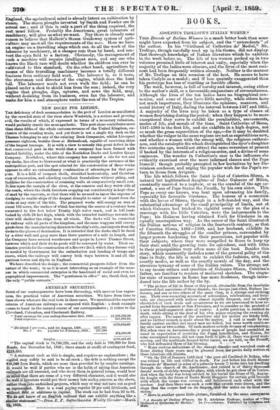NEW DOCKS FOR LONDON.
THE deficiency of dock accommodation in the port of London as manifested by the crowded state of the river above Woolwich, is a serious and growing evil, the results of which, if expressed in terms of a monetary valuation, would probably startle the most apathetic. This port alone contributes more than three fifths of the whole customs revenue of the United Kingdom, ex- clusive of the coasting trade, and yet there is not a single dry dock on the Thames belonging to any of the existing Dock Companies, whilst Liverpool possesses eighteen, besides those at Birkenhead, capable of receiving,_shipe of the largest tonnage. It is with a view to remedy this great defect in the first commercial port in the world that a company has been formed with limited liability, under the title of the Northfieet Docks and London Quays Company. Northfleet, where this company has seemed a site for wet and dry docks, lies close to Gravesend at what is practically the entrance of the metropolitan port, and the spot selected for the construction of these works appears to offer an extraordinary combination of advantages for that pur- pose. It is a field of warped chalk, stratified horizontally, and therefore easy of excavation, and affording excellent foundations without piling, and facilities for the construction of retaining walls at comparatively small cost. It lies upon the margin of the river, at the concave and deep water side of the reach, where the chalk foreshore cropping out considerably is-kept clear of mud by the currents, so that there will be no need to incur the expense of dredging to enable ships of the deepest draught to enter or depart from the docks at any state of the tide. The proposed works will occupy an area of about 165 acres, the surface of which has during the course of ¢ury been excavated to fire feet below Trinity high water mark, and is left land- locked by cliffs 70 feet high, which with the intended buildings towards the river will shelter the ships from all winds. The docks will be connected by railway with all parts of the kingdom, and the same waggons will convey goods from the manufacturing districts to the ship's side, and imports from the docks to the places of destination. It is intended that the docks shall be faced by a river wall and quay more than three quarters of a mile in. length, and the Company have secured warehouses and quays in Lower Thames Street, between which and their docks goods will ha conveyed by water. Their es- timates providafor the construction of a Reserve Dock which they foresee will be needed by Government for the embarkation and landing of troops and stores, which the railways will convey both ways between it and all the garrison towns and depots in England.
We have described the design ; the commercial prospects follow from the nature of the want ; to us it is most interesting as an example of the man- ner in which commercial enterprise is the handmaid of social and even to- pographical improvement. The "gentlemen in office" are, thank God, not the only "public servants."


























 Previous page
Previous page